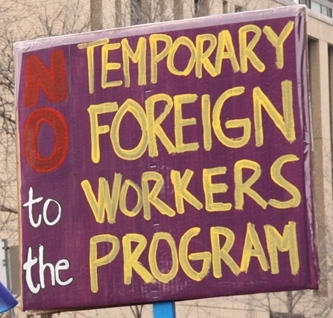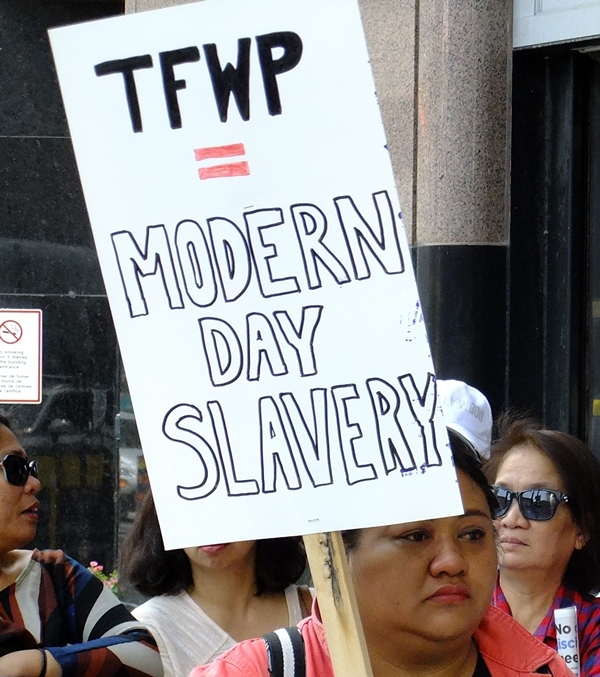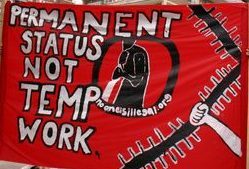The Temporary Foreign Worker Program
- Pierre Chenier -
The
fastest
growing
category
of
migrant
workers
in
Canada,
as
is
the
case
worldwide,
is
the
undocumented
worker.
Studies
and
statistics
regarding
these
workers
are
rare. One study in 2011, funded by the Canadian
Institutes of Health Research, estimated that between 200,000 and
500,000 undocumented workers live in Canada. They are concentrated in
Ontario, where they are employed mainly in construction, hospitality
and agriculture.
 The study also
showed that many of the undocumented workers began their work in Canada
as "documented workers," including through the Temporary Foreign Worker
Program (TFWP), and had become undocumented because of the conditions
of
servitude and arbitrariness that are the trademark of this program.
Among other things, many temporary foreign workers whose employment
contract with an employer is broken, whether through the employer
terminating the contract or the worker leaving the particular job due
to untenable conditions, remain in Canada as undocumented workers. The study also
showed that many of the undocumented workers began their work in Canada
as "documented workers," including through the Temporary Foreign Worker
Program (TFWP), and had become undocumented because of the conditions
of
servitude and arbitrariness that are the trademark of this program.
Among other things, many temporary foreign workers whose employment
contract with an employer is broken, whether through the employer
terminating the contract or the worker leaving the particular job due
to untenable conditions, remain in Canada as undocumented workers.
Various
governments
present
the
situation
facing
temporary
foreign
workers
as
one
governed
by
rules,
unlike
that
of
undocumented
workers.
They
say,
for
example,
that
temporary
foreign workers are covered by federal and
provincial minimum labour standards laws, have access to many social
programs and public services, and have a path to permanent residence,
while undocumented workers, although working, are considered outside
those laws and are criminalized as outlaws in a vulnerable state of
lawlessness.
The
objective
conditions
of
servitude
in
which
undocumented
workers
work
are
such
that
there
are
few
official
rules
in
force
regarding
their
employment
and
living
conditions, with most left to the dictate of the
employer. This vulnerability to arbitrary dictate includes even
documented workers within the narrow confines of the TFWP and
associated programs. Their rights are subject to
abuse, including their fundamental right to be equal members of the
polity without living under constant threat of being deported.
The
situation
for
foreign
workers
is
marked
by
the
arbitrariness
of
employers
in
Canada
and
the
agencies,
both
Canadian
and
foreign,
that
recruit
them
in
their country. Governments keep foreign workers in a
vulnerable position and open to abuse by refusing to abolish their
temporary status. Without their rights guaranteed, their dignity as
workers is denied and their precarious status is maintained.
Temporary Foreign Worker Program (TFWP)
The
federal
TFWP
includes
two
subprograms:
Live-in
Caregiver
Program
and
the
Seasonal
Agricultural
Worker
Program.
A
range
of
other
workers
also
belong
to
the
general category of temporary foreign
workers. The TFWP and the International Mobility Program (IMP) were one
program until the Harper Government made the IMP a separate program in
2014.
Labour Market Opinion
Research
conducted
by
the
Economics,
Resources
and
International
Affairs
Division
of
the
Canadian
government
found
that
on
December
1,
2013,
there
were
386,406
temporary
foreign
workers in Canada. Of these,
126,816 were subject to a labour market opinion, and 259,590 were not
subject to a labour market opinion.
 Employers who want
to recruit temporary foreign workers in general must submit a Labour
Market Impact Assessment (LMIA),
while employers who want to recruit through the IMP do not have to do
this. The requirement for an LMIA is based on the charade that the TFWP
is strictly intended to temporarily fill positions for which no
Canadian citizen or permanent resident is available. This is a charade
because foreign workers have been coming to Canada for decades to
occupy positions in many sectors, such as agriculture, live-in
caregivers,
hospitality and food processing. The positions are not
and never have been temporary, only the workers that fill those
permanent positions are temporary. Their temporary status is an
instrument to keep them vulnerable, in the lowest paid jobs, in the
worst conditions and with their rights denied, and puts downward
pressure on
wages generally. Employers who want
to recruit temporary foreign workers in general must submit a Labour
Market Impact Assessment (LMIA),
while employers who want to recruit through the IMP do not have to do
this. The requirement for an LMIA is based on the charade that the TFWP
is strictly intended to temporarily fill positions for which no
Canadian citizen or permanent resident is available. This is a charade
because foreign workers have been coming to Canada for decades to
occupy positions in many sectors, such as agriculture, live-in
caregivers,
hospitality and food processing. The positions are not
and never have been temporary, only the workers that fill those
permanent positions are temporary. Their temporary status is an
instrument to keep them vulnerable, in the lowest paid jobs, in the
worst conditions and with their rights denied, and puts downward
pressure on
wages generally.
Employers
who
recruit
workers
through
the
IMP
do
not
require
an
LMIA
because
the
program,
according
to
official
propaganda,
is
intended
to
provide
greater
competitive
advantages
to Canada economically, culturally or otherwise.
This includes, among other things, the mobility of labour under free
trade agreements. The IMP, unlike the TFWP,
includes an open work permit that does not bind the participant to a
single employer. It also offers an easier route to permanent residence
status precisely because it is seen as beneficial to Canada's
competitiveness to keep those particular workers in the country.
Temporary
foreign
workers
requiring
an
LMIA
are
contractually
bound
to
a
sole
employer
under
conditions
similar
to
indentured
labour.
The
contracted
condition
makes
it
difficult
to leave an abusive employer or dangerous
job without being subjected to immediate removal from the country
because when the contract is broken the worker no longer has a legal
status under the rules of the LMIA.
Workers
under
an
LMIA
contract
are
vulnerable
because
if
they
complain,
the
job
may
be
terminated
by
the
employer,
meaning
they
must
leave
the
country.
The action may well be done in silence because the workers are so
vulnerable, with limited legal recourse. Dismissed workers must go
through a new LMIA process, which takes months and is not assured, or
return to their country, or become undocumented workers. To change
employers, the worker must receive a new job offer from a potential
employer, and have an LMIA approved. This takes between three and five
months but that is not the end of the process. The worker must then
apply for a new work permit, which adds between three and six months.
During this long period, the worker is not eligible to work or receive
employment insurance or social assistance so may end up without income
for many months. Remembering that these workers generally receive the
lowest pay while working, the reality of their lack of income pushes
many either into returning home or becoming undocumented workers.
Without Rights Guaranteed, Workers Are Vulnerable
The
rule
of
law
must
apply
equally
to
all
without
denial
of
rights
to
some
and
privilege
to
others.
A
basic
human
right
is
not to be considered
temporary or illegal and subject to deportation or other arbitrary
measures of a police power. The entire concept of temporary worker
should be considered ultra vires
(outside the law) and without validity
within a rule of law based on a modern constitution that applies
equally to all human beings without prejudice or privilege.
 Examples abound of a
contradiction between the actual conditions of temporary, migrant and
refugee workers and the liberal democratic propaganda that says in
words that all humans are equal and protected by a rule of law that
applies to all without prejudice or privilege. Examples abound of a
contradiction between the actual conditions of temporary, migrant and
refugee workers and the liberal democratic propaganda that says in
words that all humans are equal and protected by a rule of law that
applies to all without prejudice or privilege.
The
status
of
temporary
for
workers
selling
their
capacity
to
work
to
an
employer
accords,
in
practice,
arbitrary
power
and
privilege
to
the
employer
and
subservience or voluntary servitude to the employees.
Liberal democratic law and constitutions uphold this inequality and
privilege through the accordance of superior rights to property, wealth
and social status over the rights that people have by virtue of being
human.
Many
temporary
workers
live
in
employer
provided
or
controlled
housing.
This
arrangement
gives
employers
substantial
control
over
workers'
food,
space,
sleep
and
social
networks.
Workers
can be subject to
intimidation and this situation reinforces the total imbalance of power
between the employer and worker. Often no clear boundary exists between
being on-duty and off-duty.
Examples
abound
of
abuse
by
recruitment
agencies,
both
public
and
private,
and
individual
recruiters
that
have
become
a
global
system
of
human
trafficking.
The
abuses
include the charging of exorbitant fees, false
claims and forged documents. Recruiters and employers often persuade
workers to take loans from them and subsequently add
interest and other charges for services or penalties for breaking
arbitrary rules.
Charged
large
fees,
workers
are
sometimes
issued
incomplete
or
blatantly
fake
documents,
given
false
names
of
employers
or
non-existent
jobs.
In
recent
years,
"release
upon
arrival" schemes have become more frequent.
These are schemes where workers have no employer although names are on
their papers or contracts. The workers are "released" from the phony
contract upon arrival at the airport or recruiter's office in Canada.
Sometimes such a scheme is openly offered to workers who are assured
that it will be easy to find a real employer once in Canada. In many
cases, the recruiters also keep such "released" workers in a workplace
owned or arranged by the recruiter where they have to work for room and
board while waiting for an employer who will hire them.
Temporary
foreign
workers
pay
income
tax
and
sales
tax
and
contribute
to
the
Canada
Pension
Plan
and
the
Employment
Insurance
(EI)
regime.
However,
they
are
not entitled to regular EI benefits for their periods of
unemployment once their employment contract is terminated. Officially,
they are entitled to other EI benefits, such as parental or maternity
benefits, but these become almost impossible for them to access once
their official employment contract is terminated.
Temporary
foreign
workers
are
supposed
to
be
covered
by
minimum
labour
standards
and
occupational
health
and
safety
laws,
but
enforcement
is
an
issue.
Their
vulnerable
status makes it very difficult for them to insist that
the employer respect the existing laws or to call upon the government
to provide redress and official enforcement is reported to be unseen.
In
theory,
temporary
foreign
workers
have
the
right
to
permanent
residence
status
but
no
path
to
status
exists
within
the
program.
They
can
acquire
sponsorship
from their employer, but usually the employer has
no incentive to do so. The applicant must master an official language
but usually their working conditions, including long hours without
structured breaks, prohibit them from attending classes, if they exist
in their region, or regularly fraternizing with English or French
speakers through organized social or sports events.
 The Live-in
Caregiver Program does include a route to permanent residence, but
caregivers, the vast majority of them women, are subject to a two-step
immigration process that requires they enter Canada with temporary
status and an employment contract but without their families. They must
complete their contract before they can apply for permanent residence,
which presents problems of what to do after the contract finishes. The
program for permanent residence also includes a cap on applications,
which is yet another restriction. This year, after sustained work by
live-in caregivers and their supporters, the federal government
announced two "pilot projects" to run over the next five years, that
will allow those recruited in this category of workers to come to
Canada with their families. Once a caregiver has their work permit and
two years of experience, it is said they will then have "access to a
direct pathway to permanent residence." As well, a small window is
presently open this year to retroactively provide such "access" for
caregivers already in Canada who came to the country with the
expectation that they could apply for permanent residency, only to find
out later that this was not possible under the programs through which
they were recruited. The Live-in
Caregiver Program does include a route to permanent residence, but
caregivers, the vast majority of them women, are subject to a two-step
immigration process that requires they enter Canada with temporary
status and an employment contract but without their families. They must
complete their contract before they can apply for permanent residence,
which presents problems of what to do after the contract finishes. The
program for permanent residence also includes a cap on applications,
which is yet another restriction. This year, after sustained work by
live-in caregivers and their supporters, the federal government
announced two "pilot projects" to run over the next five years, that
will allow those recruited in this category of workers to come to
Canada with their families. Once a caregiver has their work permit and
two years of experience, it is said they will then have "access to a
direct pathway to permanent residence." As well, a small window is
presently open this year to retroactively provide such "access" for
caregivers already in Canada who came to the country with the
expectation that they could apply for permanent residency, only to find
out later that this was not possible under the programs through which
they were recruited.
In
2014,
in
the
midst
of
mass
media
coverage
of
certain
employers
abusing
the
TFWP,
the
Harper
government
intervened
in
such
a
manner
to
create
friction between Canadian workers and temporary workers. The government
made a big deal of giving Canadian workers priority over temporary
workers for available jobs. In the process, the government made the
eligibility criteria for employment insurance even more stringent for
all workers and further limited foreign workers' access to any EI
benefits. A goal of all these programs, aside from providing cheap
workers for employers, is to discourage unity of the working class in
defence of its rights.
The
federal
government
gradually
reduced
the
percentage
of
eligible
foreign
workers
relative
to
a
company's
total
workforce
to
10
per
cent
by
2016.
According
to
the workers' defence organizations, as the percentage was
lowered some temporary foreign workers who had arrived when the
percentage was higher were suddenly fired and forced to work
underground to stay in Canada. In response to the lower allowable
percentage, certain regular employers of temporary workers campaigned
to have the percentage relaxed. The Trudeau government complied,
raising
the level to 20 per cent, a figure that still retains its arbitrariness
as far as temporary workers are concerned as they become disposable
when the percentage is exceeded.
The
Harper
government
in
2014
also
changed
the
rules
so
that
the
federal
government
may
refuse
applications
for
the
hiring
of
temporary
foreign
workers
for
low-paid positions in the accommodation and food services
and retail trade sectors in areas where the official unemployment rate
is equal to or higher than six per cent. The Trudeau government has
endorsed the change. Again, this pits workers against one another in
that foreign workers are indirectly blamed for causing hardship for
Canadian workers as competitors willing to accept low wages and
precarious work. This perpetuates the imperialist consciousness that
obfuscates the class conflict between the working class and a ruling
financial oligarchy as the root of all the problems facing workers and
the socialized economy, and why workers are routinely deprived of their
rights and the economy suffers recurring crises and its basic problems
remain unsolved.
This article was published in

Volume 49 Number
15 - April 27, 2019
Article Link:
The
Temporary Foreign Worker Program
Website: www.cpcml.ca
Email: editor@cpcml.ca
|



